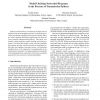37 search results - page 2 / 8 » Termination, Deadlock and Divergence |
LISP
2008
13 years 5 months ago
2008
Higher-order logic proof systems combine functional programming with logic, providing functional programmers with a comfortable setting for the formalization of programs, specifica...
BMCBI
2006
13 years 5 months ago
2006
Background: Molecular evolutionary studies of noncoding sequences rely on multiple alignments. Yet how multiple alignment accuracy varies across sequence types, tree topologies, d...
TASE
2007
IEEE
13 years 11 months ago
2007
IEEE
Software model checkers work directly on single-process programs, but not on multiple processes. Conversion of processes into threads, combined with a network model, allows for mo...
FSEN
2009
Springer
13 years 12 months ago
2009
Springer
Abstract. We study termination of programs in concurrent higherorder languages. A higher-order concurrent calculus combines features of the λ-calculus and of the message-passing c...
LATA
2009
Springer
14 years 3 days ago
2009
Springer
Introducing priorities on rules in rewriting increases their expressive power and helps to limit computations. Priority rewriting is used in rule-based programming as well as in f...

